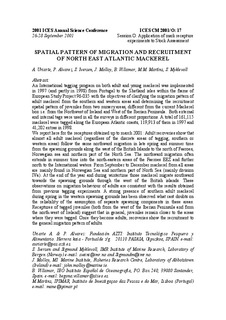| dc.contributor.author | Uriarte, A. | |
| dc.contributor.author | Alvarez, Paula | |
| dc.contributor.author | Iversen, Svein A. | |
| dc.contributor.author | Molloy, John | |
| dc.contributor.author | Villamor, Begoña | |
| dc.contributor.author | Martins, Maria Manuel | |
| dc.contributor.author | Myklevoll, Sigmund | |
| dc.date.accessioned | 2012-10-22T18:07:24Z | |
| dc.date.available | 2012-10-22T18:07:24Z | |
| dc.date.issued | 2001 | |
| dc.identifier.citation | This report is not to be cited without prior reference to the authors | no_NO |
| dc.identifier.uri | http://hdl.handle.net/11250/106167 | |
| dc.description.abstract | An International tagging program on both adult and young mackerel was implemented
in 1997 (and partly in 1998) from Portugal to the Shetland isles within the frame of
European Study Project 96-035 with the objectives of clarifying the migration pattern of
adult mackerel from the southern and western areas and determining the recruitment
spatial pattern of juveniles from two nursery areas, different from the current Mackerel
box i.e. from the Northwest of Ireland and West of the Iberian Peninsula. Both external
and internal tags were used in all the surveys in different proportions. A total of 161,115
mackerel were tagged along the European Atlantic coasts, 119,913 of them in 1997 and
41,202 extras in 1998.
We report here for the recaptures obtained up to march 2001: Adult recoveries show that
almost all adult mackerel (regardless of the discrete areas of tagging, southern or
western areas) follow the same northward migration in late spring and summer time
from the spawning grounds along the west of the British Islands to the north of Faeroes,
Norwegian sea and northern part of the North Sea. The northward migration often
extends in summer time into the north-eastern areas of the Faeroes EEZ and further
north to the International waters. From September to December mackerel from all areas
are mainly found in Norwegian Sea and northern part of North Sea (mainly division
IVa). At the end of the year and during wintertime those mackerel migrate southward
towards the spawning grounds through the west of the British islands. These
observations on migration behaviour of adults are consistent with the results obtained
from previous tagging experiments. A strong presence of southern adult mackerel
during spring in the western spawning grounds has been observed what cast doubts on
the reliability of the assumption of separate spawning components in these areas.
Recaptures of tagged juveniles (both from the west of the Iberian Peninsula and from
the north-west of Ireland) suggest that in general, juveniles remain closer to the areas
where they were tagged. Once they become adults, recoveries show the recruitment to
the general migration pattern of adults. | no_NO |
| dc.language.iso | eng | no_NO |
| dc.publisher | ICES | no_NO |
| dc.relation.ispartofseries | ICES CM Documents;2001/O:17 | |
| dc.subject | mackerel | no_NO |
| dc.subject | makrell | no_NO |
| dc.subject | fish migration | no_NO |
| dc.subject | vandringer | no_NO |
| dc.subject | tagging | no_NO |
| dc.subject | merking | no_NO |
| dc.subject | recruitment | no_NO |
| dc.subject | rekruttering | no_NO |
| dc.title | Spatial pattern of migration and recruitment of north east Atlantic mackerel | no_NO |
| dc.type | Working paper | no_NO |
| dc.subject.nsi | VDP::Mathematics and natural science: 400::Zoology and botany: 480::Ethology: 485 | no_NO |
| dc.subject.nsi | VDP::Mathematics and natural science: 400::Geosciences: 450::Oceanography: 452 | no_NO |
| dc.source.pagenumber | 40 s. | no_NO |
